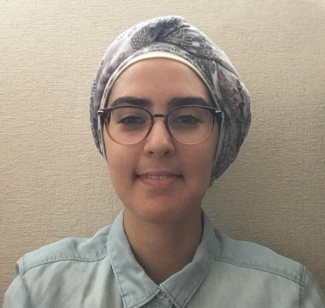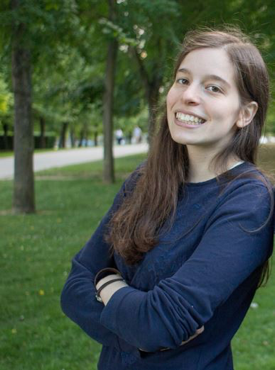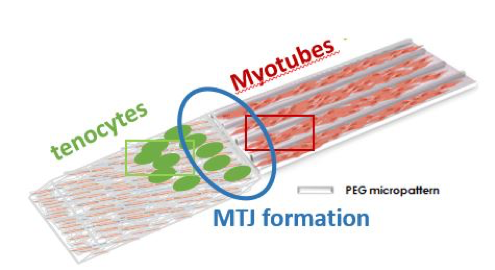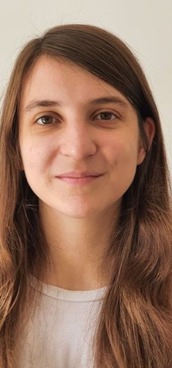The i-Bio program awarded 4 PhD fellowships in 2020.
- Mazzarine DOTOU, supervisors: Chahrazade EL AMRI & Roba MOUMNE
Towards optimized bifunctional senolytic compounds: design, evaluation, and proof of concept during skeletal muscle stem cells ageing. - Soumaiya IMARRAINE, supervisors: Elim HONG & Raphaël CANDELIER
Identifying the role of cholinergic signaling in the aversive brain. - Rosa NICOLAS, supervisors: Delphine DUPREZ & Cécile LEGALLAIS
Tissue engineering for the myotendinous junction - Jeanne TRINQUIER, supervisors Martin WEIGT & Francesco ZAMPONI
Data-driven generative modeling of protein sequence landscapes.
Meeting with Mazzarine DOTOU

My scientific background
Highly interested by chemistry and biology, I did all my studies in both domains. During my master, I worked on 2 projects in academic and industrial research. In both cases, I used biology to develop in vitro models, and chemistry to investigate how drugs can act on them. Those experiences motivate me to conduct an interdisciplinary PhD in applied research on a subject that could have a real impact on people lives.
What attracts me to the PhD experience
A PhD is a chance to get not only technical skills but also more confidence to analyse and solve scientific problems. It is also a social adventure : I will interact, share, and exchange ideas but also learn from others. I will work in the B2A lab (Sorbonne) but also in the LBM lab (ENS). Working in two labs with recognized expertise in biology and chemistry inspires and motivates me!
My future research
During my PhD, I will work on senescent stem cells in skeletal muscle. Characterized by morphological and metabolic specific features, senescent cells are linked to chronological ageing and their accumulation over time has been shown to compromise normal tissue function and to contribute to development of age-associated diseases. Innovative therapeutical molecules, called senolytics, that target senescent cells would be of great interest. However, current available compounds are characterised by a lack of specificity. The main objective of my project is to produce bifunctional compounds composed of a senolytic linked to a ligand known to specifically target senescent cells. In a first step, I will conduct chemical synthesis experiments to design and purify such compounds. This step will be followed by their biological evaluation, i.e. the measure of their effects in vitro in senescent muscle stem cells, and in vivo in mice. This will bring us the first proof of concept that such compounds can be used in vivo and makes my PhD challenging and valuable! I cannot wait to start!
Figure

Find out more
[1] Campisi, J. Senescent Cells, Tumor Suppression, and Organismal Aging: Good Citizens, Bad Neighbors. Cell 120, 513–522 (2005).
[2] Martel, J. et al. Emerging use of senolytics and senomorphics against aging and chronic diseases. Med. Res. Rev. med.21702 (2020) doi:10.1002/med.21702
[3] Sousa-Victor, P., Gutarra, S., García-Prat, L. et al. Geriatric muscle stem cells switch reversible quiescence into senescence. Nature 506, 316–321 (2014). https://doi.org/10.1038/nature13013
Contact
Mazzarine DOTOU
Email: mazzarine.dotou at sorbonne-universite.fr
https://www.linkedin.com/in/mazzarinedotou/
- Team “Integrative cellular ageing and inflammation”
Biological Adaptation and Ageing (B2A), UMR 8256, CNRS, Sorbonne Université
Institut Biologie Paris-Seine
7-9 quai Saint Bernard
75 252 Paris CEDEX, France
https://www.ibps.upmc.fr/en/research/biological-adaptation-and-ageing - Laboratoire des BioMolécules (LBM), CNRS UMR 7203, ENS-PSL, Sorbonne Université
Ecole Normale Supérieure
24 rue Lhomond
Paris 75005, France
https://lbm.cnrs.fr/
Meeting with Soumaiya IMARRAINE

My scientific background
I am fascinated by neuroscience, especially by the mechanisms controlling behavior, which I have studied from the perspective of neuroscience, genetics, and social sciences. I did several internships in France and abroad, which allowed me to meet researchers and PhD students from different parts of the world. These experiences have inspired me to do a PhD degree to keep working on research projects in neuroscience.
What attracts me to the PhD experience
I am excited about doing a PhD as it will give me the opportunity to work in depth on a long-term project in which I am particularly interested. I will learn to manage my own project, adapt to the results and implement new ideas. I am also really enthusiastic about learning new techniques, sharing my work and interacting with the scientific community, and transmitting my knowledge to other students.
My future research
Studies have linked prenatal nicotine exposure to neurobehavioral defects. In the brain, nicotine binds highly to cholinergic neurons of the habenulo-interpeduncular nucleus, an evolutionary conserved region known as the ‘aversive brain’ due to its role in mediating stress, fear and anxiety.
My project aims to understand how cholinergic signalingplays a role in regulating the activity and function of the aversive brain, using the zebrafish model system. To do so, I will use genetically modified zebrafish larvae, calcium imaging, behavioral assays and analytical models.
This project perfectly fits my interest for behavioral neuroscience and my wish to work in an interdisciplinary environment. I am excited to benefit from the expertise of my two supervisors, Dr Elim Hong, a neuroscientist, and Dr Raphaël Candelier, a physicist and data scientist. This project will allow me to use cutting edge imaging techniques to acquire a multitude of information on neuronal activity and to use modeling to interpret them.
Find out more
[1] deCarvalho, T.N., Subedi, A., Rock, J., et al. Neurotransmitter map of the asymmetric dorsal habenular nuclei of zebrafish. Genesis. 2014; 52: 636-655. doi:10.1002/dvg.22785 (https://onlinelibrary.wiley.com/doi/full/10.1002/dvg.22785)
[2] Hong E., Santhakumar K., Akitake C.A., et al. Left-right asymmetry in cholinergic neural pathway. Proceedings of the National Academy of Sciences. 2013, 110 (52) 21171-21176; DOI: 10.1073/pnas.1319566110 (https://www.pnas.org/content/110/52/21171)
Contact
Soumaiya IMARRAINE
Email: soumaiya.imarraine at sorbonne-universite.fr
- Team “Formation and interaction of neural networks” (FINN)
NeurosciencesParis Seine (NPS), CNRS UMR 8246, INSERM U1130, Sorbonne Université
7-9 quai Saint Bernard, Bâtiment Cassan A3, 312-314, Case 37
Institut de Biologie Paris Seine
75 252 Paris CEDEX, France
https://www.honglab.fr/ - Laboratory Jean Perrin (LJP), CNRS UMR 8237, Sorbonne Université
Institut de Biologie Paris Seine
4, place Jussieu, Tour 32-33, Case 114
75005 Paris, France
http://www.labos.upmc.fr/ljp/
Meeting with Rosa NICOLAS

My scientific background
My name is Rosa Nicolas and I am a biomedical engineer. During my studies, I followed courses and encountered people that have strengthened my will to become a researcher and showed me that I really enjoy working in a research environment, learning new scientific advances and participating in innovative research projects. I have studied and realised enriching projects on various scientific topics among which I discovered a fascinating research theme: tissue engineering that I wanted to study in a PhD.
What attracts me to the PhD experience
I find the PhD experience genuinely inspiring and enriching as it allows us to actively participate in a research project that we are passionate about, bring forward research and gain new skills. This program also maintains our general knowledge on other scientific topics thanks to the several meetings that are offered which I believe is very appealing.
My future research
My PhD project, entitled “tissue engineering of the myotendinous junction” (MTJ), is under the supervision of Dr Duprez from the IBPS and of Dr Legallais from the UTC. Based on previous results from both supervisors, we aim to better understand the molecular and mechanical cues that mediate the formation of the MTJ and to tissue engineer an in vitro model of the MTJ.
MTJ injuries are a public health issue and remain poorly studied which is why I wanted to take part into this captivating project. Also, this PhD combines several disciplines including fundamental biology and bio-engineering (tissue engineering) approaches which I find challenging. This interdisciplinarity is critical as we need to take into account all aspects (biological, mechanical…) in and around the cell to better understand the reasons of its change and the formation of a complex structure like the MTJ. In the end, it will drive us forward to propose a relevant new in vitro model for future studies regarding this matter.
Figure

Find out more
[1] Esteves de Lima J., Blavet C., Bonnin M-A, et al.BMP signalling directs a fibroblast-to-myoblast conversion at the connective tissue/muscle interface to pattern limb muscles. bioRxiv 2020.07.20.211342; doi: https://doi.org/10.1101/2020.07.20.211342
[2] Beldjilali-Labro M, Garcia Garcia A, Farhat F, et al. Biomaterials in Tendon and Skeletal Muscle Tissue Engineering: Current Trends and Challenges. Materials (Basel). 2018;11(7):1116. Published 2018 Jun 29. doi:10.3390/ma11071116
[3] Havis E and Duprez D. EGR1 Transcription Factor is a Multifaceted Regulator of Matrix Production in Tendons and Other Connective Tissues. International Journal of Molecular Sciences. 2020;21:1664. Published 2020 Feb 28. doi:10.3390/ijms21051664
Contact
Rosa NICOLAS
Email: rosa.nicolas1996 at gmail.com
- Team “Muscle and tendon formation and repair”
Developmental Biology Laboratory (LBD), UMR7622, CNRS, INSERM, Sorbonne Université
Institut Biologie Paris Seine
7-9 Quai Saint-Bernard, Bâtiment Cassan, C6E, Case 24
75252 Paris Cedex 05 France
https://www.ibps.upmc.fr/en/research/developmental-biology-laboratory/muscle-and-tendon-formation-and-repair - Unité BMBI – Université de Technologie de Compiègne
Rue du docteur Schweitzer CS 60319
60203 COMPIEGNE Cedex France
https://bmbi.utc.fr/
Meeting with Jeanne TRINQUIER

My scientific background
I first began by doing a 3-years degree of physics in Paris. I was interested in theoretical and interdisciplinary topics. Therefore, I decided to follow the master of Physics of Complex Systems. Complex systems are present in a lot of very different situations, so you can apply the same tools in biology and finance for example. During this master, I met a lot of researchers that were teaching extremely interesting topics such as statistical physics, and I decided to deepen some subjects by doing a PhD.
What attracts me to the PhD experience
I like the fact that you can study a subject during a relatively long time, and this subject doesn’t have a known solution, so you are free to explore a lot of different directions. I also like to be able to interact with a lot of different people coming from different backgrounds, the PhD directors but also the other PhD students because we can share interesting ideas and work together on specific questions.
My future research
I will work on generative models for families of protein sequences. In these families, there are a lot of different protein sequences coming from very different species but with a common biological function and structure. These sequences exhibit a high variability due to evolution. The aim of the PhD is to find a statistical model that can model a family and generate new artificial sequences that are indistinguishable with respect to the natural sequences, with interesting applications for protein design. The different models that are going to be tested are coming from both statistical physics and machine learning. What motivated me in this choice of subject is its interdisciplinary nature, methods coming from physics and computer science are applied to a real biological problem with both fundamental questions such as understanding the evolutionary constraints in families of proteins, and very concrete applications such as predicting the effect of a mutation in a protein.
Jeanne’s first paper on her thesis work is published in the journal Nature Communications. The authors propose a new and very efficient computer modeling approach called “generative” which allows to design artificial protein sequences statistically equivalent to natural sequences, a feature of great interest in the field of protein design (Article: https://doi.org/10.1038/s41467-021-25756-4, Press release: Vers une conception de nouvelles protéines par apprentissage statistique).
Figure

Find out more
[1] Inverse statistical physics of protein sequences: a key issues review, Reports on Progress in Physics, Simona Cocco, Christoph Feinauer, Matteo Figliuzzi, Rémi Monasson and Martin Weigt. 2018 arXiv :1703.01222//doi: 10.1088/1361-6633/aa9965
Contact
Jeanne TRINQUIER
Email: jeanne.trinquier at phys.ens.fr
- Team “Statistical genomics and biological physics”
Laboratory of Computational and Quantitative Biology (LCQB), UMR7238, CNRS, Sorbonne Université
Institut de Biologie Paris Seine
7-9 quai Saint Bernard, Bâtiment Cassan C4
75 252 Paris CEDEX, France
https://www.ibps.upmc.fr/en/research/computational-and-quantitative-biology/statistical-genomics-and-physics - Laboratoire de Physique de l’ENS (LPENS), CNRS, Université de Paris, Sorbonne Université
24 rue Lhomond
Paris 75005, France
https://www.lpens.ens.psl.eu/
